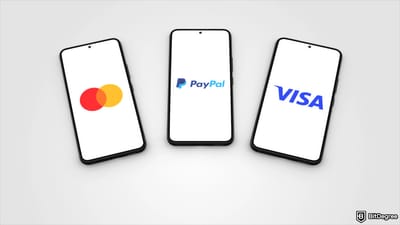Key Takeaways
- Chainlink staking enables you to earn additional LINK tokens as a reward for contributing to the security and reliability of the network;
- You can choose where to stake Chainlink according to your resources – it can be on centralized exchanges and direct network staking;
- The method you pick on how to stake Chainlink can affect the rewards you receive, the level of control you have over your tokens, and the overall risk involved.
Stop overpaying - start transferring money with Ogvio. Join the waitlist & grab early Rewards NOW! 🎁
Have you been holding onto LINK tokens, eager to unlock their full potential? Look no further than Chainlink staking! This innovative system allows you to not only earn rewards on your LINK holdings but also become an active participant in securing the Chainlink network.
Interestingly, you can join with as little as 1 LINK token (or about USD 14.47 as of the time of writing) – the barrier to entry is very low!
To get you started, I'll equip you with the basic concept of Chainlink staking, from how it works to its benefits and considerations. We'll also explore different methods on how to stake Chainlink, weighing the risks and rewards to ensure you make an informed decision about where to stake your LINK tokens.
Besides, if you don't have LINK tokens yet, you can get them on exchanges like Binance, Bybit, and Kraken.

Did you know?
Subscribe - We publish new crypto explainer videos every week!
Proof of Work vs Proof of Stake: Which is Better? (ANIMATED)


Table of Contents
What Is Chainlink Staking?
Chainlink staking is a security and incentive system built into the Chainlink network. The main purpose is to improve the network's security by requiring participants (called node operators and community members) to stake their LINK tokens, the native cryptocurrency of the network.
Latest Deal Active Right Now:Staking cryptocurrency generally involves locking up a portion of their holdings for a set period, with the potential to earn rewards[1]. In the context of Chainlink staking, participants essentially become more invested in the network's success when they stake their LINK tokens.
Reliable node operators who provide accurate data are rewarded, while those who deliver unreliable information risk losing a portion of their staked LINK. This system discourages malicious behavior and incentivizes high-quality data, ultimately maintaining the security and functionality of the Chainlink network.

For your information, Chainlink staking is a core feature of Chainlink Economics 2.0. Well, its first version (v0.1) was launched in December 2022 and marked a big step towards a more secure and sustainable network.
While v0.1 laid the groundwork, Chainlink staking v0.2 represents a complete overhaul. It's designed to be more modular, adaptable, and upgradable for the future. It takes learnings from the previous version and focuses on reaching these key objectives:
- More freedom for staking. Chainlink staking v0.2 introduces a new system for "unbonding" staked tokens, giving both community members and node operators better flexibility in managing their stakes. With unbonding, they can potentially react to market changes and withdraw their LINK tokens if needed, even though they initially committed to staking.
- Stronger network security. This new version uses a "slashing" mechanism that penalizes node operators who deliver inaccurate data by reducing their staked LINK tokens. This strengthens the overall security of the Chainlink oracle services.
- Adaptable for future growth. Chainlink staking v0.2 is built with a modular architecture. This allows for easier integration of future improvements and functionalities to the network, such as supporting additional services.
- Better rewards system. v0.2 uses a dynamic rewards mechanism that can seamlessly adapt to incorporate new ways to earn additional tokens in the future. This can include user fees or other external sources.
Besides the goals to be more adaptable and upgradeable, Chainlink staking v0.2 developers added a larger pool of LINK tokens to make staking more accessible. As of writing, this pool holds 45 million LINK, which is 8% of all circulating LINK tokens. This means a wider range of LINK token holders can now participate in staking.
How Chainlink Staking Works?
Before we talk about Chainlink staking, let's revisit the basic concept of the Chainlink network and delve into how it uses oracles to connect smart contracts with the real world.
Chainlink, in the context of cryptocurrency, refers to a decentralized oracle network. This means it's not controlled by a single entity or organization. Instead, it's a distributed network of nodes (computers or devices that work together).
Further, an oracle, in the blockchain world, acts as a bridge between a blockchain and the real world. It fetches data from external sources (like weather data, stock prices, or payment information) and delivers it securely to smart contracts on the blockchain. That way, Chainlink can fill the gap by providing a secure way for those tools to access real-world information through its network of oracles.

Smart contracts are self-executing agreements stored on a blockchain. They need external data to function properly, but blockchains themselves can’t access this data directly.
Essentially, Chainlink allows smart contracts to interact with the real world by gathering and verifying data from external sources.
Imagine a smart contract as a fancy vending machine. It can follow specific rules and give you items if certain conditions are met. However, the vending machine can't check the weather itself to see if it's sunny for ice cream or rainy for hot cocoa.
This is where Chainlink comes in. It's like a reliable friend for the vending machine. Chainlink can access real-world information (like weather data) and tell the vending machine what's going on outside. With this information, the vending machine (smart contract) can make its own decisions based on the real world.
Now, to make sure Chainlink's information is always reliable, it introduces Chainlink staking. It’s where users are incentivized to contribute to the network's security and integrity by staking LINK tokens.
The LINK token fuels the Chainlink network[2]. It serves two key purposes:
- Paying for oracle services. Users who need data from outside the blockchain pay Chainlink nodes with LINK tokens for access.
- Incentivizing accurate data. Network nodes stake their own LINK tokens. Nodes with a larger stake are more likely to be chosen to provide data, encouraging them to ensure its accuracy.
Users with LINK tokens who want to actively contribute to the network's security and integrity can join through two main staking pools: node operator staking and community staking.
Node Operator Staking

Node operator staking is the “engine room” of Chainlink staking, where those running Chainlink oracles directly contribute to the network's security and earn rewards for providing accurate data. This pool is specifically designed for users who actively run Chainlink oracles and need a high minimum stake ( a minimum of 1,000 LINK and a maximum of up to 75,000 LINK).
The large stake translates to a more robust security deposit for the network. This discourages malicious behavior as there's a bigger potential loss for nodes who try to manipulate data feeds.
To implement this, Chainlink staking uses a concept called slashing. If a node operator consistently delivers unreliable data or exhibits malicious behavior, a portion of their staked LINK tokens is automatically slashed (removed). This acts as a penalty, discouraging manipulation and incentivizing accurate data delivery.
Well, the stakes are higher, and so is the reward! With a larger stake on the line, node operators are financially motivated to keep their oracles running smoothly and delivering reliable data. It pays off more to be good at this job!
However, successfully running a Chainlink oracle typically needs a good understanding of blockchain technology and the specific technicalities involved in the operations. The node operators have to bear greater responsibility for the data they provide.
Community Staking

While node operator staking is more involved, community staking is simpler. There's no technical knowledge required to join the Community Staking pool. Users simply lock up their LINK tokens and delegate the responsibility of running oracles to node operators.
Moreover, the staked token requirement is generally much lower than node operator staking (only a minimum of 1 LINK and up to a maximum of 15,000 LINK). This low baseline makes it easy for anyone with a small amount of LINK tokens to participate, broadening the number of users contributing to network security.
However, community staking participants don't have direct control over the oracles that use the collective stake. They rely on node operators to maintain reliable data delivery.
Also, let’s spill the truth: Compared to node operator staking, the potential Chainlink staking rewards in this approach are typically lower because the individual stake size is smaller, and the rewards are distributed across a larger pool of participants.
Don’t worry, even with a smaller stake, users have the opportunity to earn rewards. These rewards come from the overall network activity and the delegation fees paid by node operators who benefit from the collective stake in the pool.
If you're still confused about the specifics of each staking pool, fear not! This table provides a quick breakdown of community staking and node operator staking
| Community Staking | Node Operator Staking | |
| Minimum Stake | Lower (min. 1 LINK) | Higher (min. 1,000 LINK) |
| Technical Knowledge | Not required | Required |
| Control | Limited control over oracles | Direct control over oracles |
| Ease of Use | Simple | More involved |
| Potential Rewards | Lower | Higher |
| Best For | Beginners, those with smaller holdings | Experienced users, those running oracles |
Table: The comparison of community staking and node operator staking.
Overall, community staking offers a user-friendly and accessible way for anyone to participate in Chainlink staking but with limited reward amounts and control. Meanwhile, node operator staking is a more advanced option for those actively contributing to the network. It demands higher staking requirements but comes with higher rewards and control.
Benefits of Staking Chainlink
Chainlink staking offers several advantages for both the network and individual stakers.
For the network, staking acts as a powerful security booster. Oracles essentially put down a deposit in LINK tokens to do their job well – providing accurate information.
If they consistently deliver misleading data, they risk losing their deposit. This mechanism makes cutting corners a gamble they're unlikely to take, encouraging them to be more careful and trustworthy. As a result, the entire Chainlink network benefits from better security and reliability.
Another benefit is increased decentralization. Staking allows a wider range of participants to contribute to the network's security. This broader participation helps to decentralize Chainlink, making it less susceptible to manipulation or control by any single entity.
Active participation from a large number of users also indicates a stronger reputation, bringing trust and confidence among developers and users.

A secure and reliable network with a strong staking system is more attractive to developers building DeFi applications. This can lead to a wider range of innovative applications built on Chainlink, further solidifying its position as a leading player in the oracle space.
Meanwhile, for users, staking allows them to earn LINK tokens simply for contributing to network security. Here's a breakdown of the potential incentives users can enjoy:
- LINK tokens. Earning additional LINK tokens is the core reward of Chainlink staking. This passive income is generated simply by locking up your LINK tokens for a designated period, and you get a certain amount of LINK earned depending on the pool you choose and the overall network activity.
- Community support bonus. If you're a node operator, a portion of your staking rewards goes towards oracles (data providers), who supply crucial information to the network. In return for this support, you receive a share of the fees paid by community stakers. It's a win-win – you earn extra LINK while helping Chainlink function smoothly.
Besides giving profits, Chainlink staking with its two staking pools offers flexibility, appealing to different preferences. This means users can choose a staking option that aligns with the risk tolerance and desired level of involvement.
It also keeps things accessible for everyone. With a minimum requirement of just 1 LINK for Community Staking, anyone can jump in and contribute to the network's security.
Moreover, this activity allows individuals to contribute to the success of Chainlink, one of the key players in the DeFi space. This can be appealing to those who want to be actively involved in the future of blockchain technology.
While Chainlink staking currently doesn't offer direct voting rights on governance decisions, there are ways your participation as a staker can influence the project's future direction. For example, active engagement in Chainlink forums and discussions can allow stakers to voice their opinions and influence the project's development through shared ideas and feedback.
Risks and Considerations
From the previous section, you may have noticed that Chainlink staking offers potential rewards for securing the network. However, you need to be aware that it comes with several risks and some aspects to consider.
Understanding this double-sided coin before committing your LINK tokens is important because it allows you to make an informed decision that aligns with your investment goals and risk tolerance.
For instance, staking involves locking up your LINK tokens for a predetermined period. This means you can’t freely trade or sell them during this time. This lack of liquidity can be inconvenient if you need quick access to your funds or if there's a sudden surge in the price of LINK.
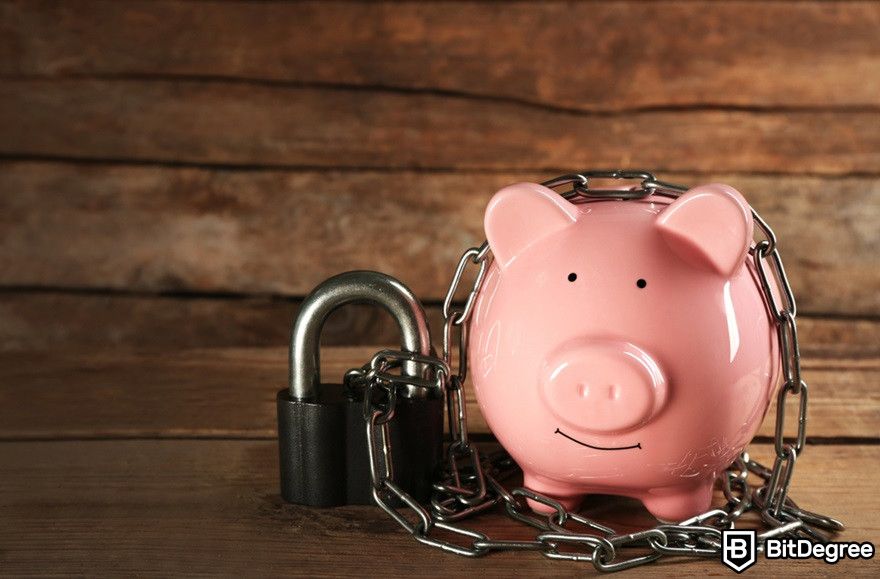
Additionally, the value of LINK can fluctuate significantly. While you might earn additional LINK tokens through staking, the overall value of your holdings could decrease if the price of LINK drops during the staking period. This could potentially negate any Chainlink staking rewards earned.
You should also be aware of the potential for smart contract exploits because Chainlink staking relies on smart contracts. If these contracts contain bugs or vulnerabilities, they could be exploited by malicious actors, potentially leading to the loss of your staked LINK tokens.
Therefore, choosing a reputable platform with a well-established track record for secure smart contracts to stake Chainlink is important. This applies whether you're staking directly on the Chainlink network or through a third-party service provider.
How to Stake Chainlink?
Ready to join the world of Chainlink staking and earn rewards while supporting the network? I'll walk you through the process of staking your LINK tokens, from choosing where to stake Chainlink to safeguarding your asset. Let's get started!
Recommended Platforms
You've familiarized yourself with the potential of staking Chainlink (LINK) and the benefits it offers. Now it's time to choose the right place among many crypto-staking platforms that best suit your needs.
One common option for staking Chainlink is through centralized exchanges (CEXs) like Binance and KuCoin. These platforms offer a user-friendly experience that makes staking Chainlink accessible to beginners and experienced users.
You can easily search for LINK staking products, view details like APY (Annual Percentage Yield) and lock-up periods, and commit your tokens with just a few clicks. No need to worry about complex technical setups or managing your own private keys.
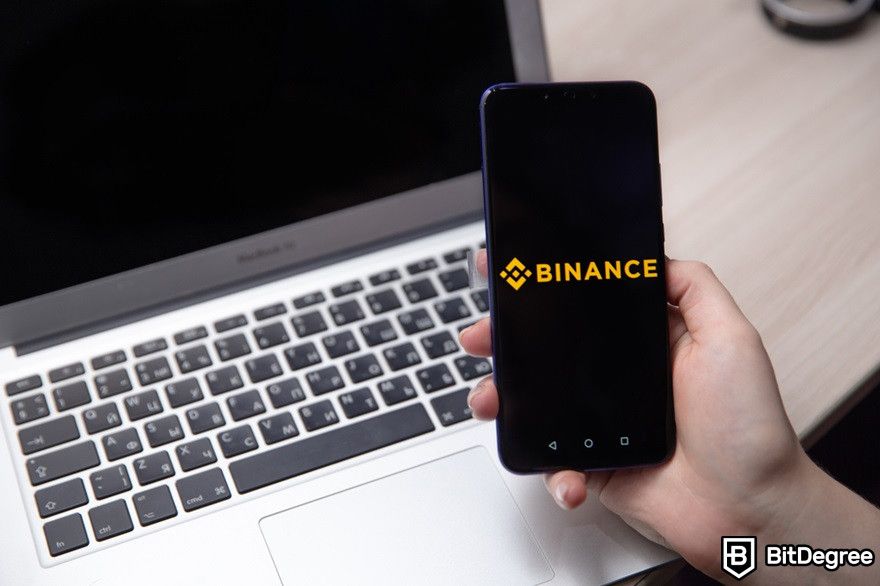
Moreover, some CEXs allow you to purchase LINK directly using fiat currencies (like USD or EUR) with your debit/credit card or bank transfer. This eliminates the need for complex cryptocurrency exchange steps before you can start staking.
On KuCoin, for example, you can buy LINK with different methods, from debit/credit card and bank transfer to third-party payment processors and KuCoin Spot Market.
The main drawback of staking Chainlink on CEX is that it's like handing them the spare key to your wallet. They keep your LINK tokens safe (supposedly!), but you can't access them directly until the staking period ends. This might be a concern if you want more control over your crypto or worry about the exchange's security measures.
Additionally, some exchanges may hold onto your tokens for the duration of the staking period, so you can't immediately sell them to take advantage of a potential price rise in another cryptocurrency. CEXs might also charge fees for staking, including deposit/withdrawal fees and platform-specific staking fees. These fees can eat into your potential returns, so be sure to factor them in when comparing different staking products.
Besides CEXs, you have the option to stake directly on the Chainlink network (staking.chain.link). This approach lets you maintain control over the tokens throughout the staking process, meaning you hold the private keys and can manage your tokens without relying on a third party.
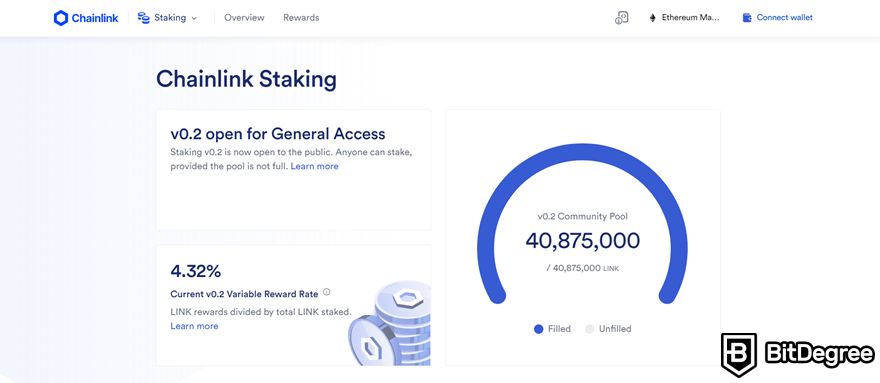
Staking directly on the network also allows you to interact with the blockchain protocol itself, potentially offering greater transparency and security compared to relying on a third-party exchange.
Moreover, staking directly on the network often offers higher APYs compared to doing it on centralized exchanges (CEXs). This is because you're contributing directly to network security and receiving a larger share of the Chainlink staking rewards generated.
While this option has multiple benefits, it comes with several trade-offs you have to consider.
For example, staking Chainlink directly on the network involves a steeper learning curve. You may need to understand complex concepts like wallet management, potentially interacting with smart contracts, and even the inner workings of blockchain technology.
The responsibility also falls on you to keep your tokens safe. This involves choosing a secure crypto wallet, safeguarding your private keys, and maybe running a node to validate transactions (although this isn't always necessary).
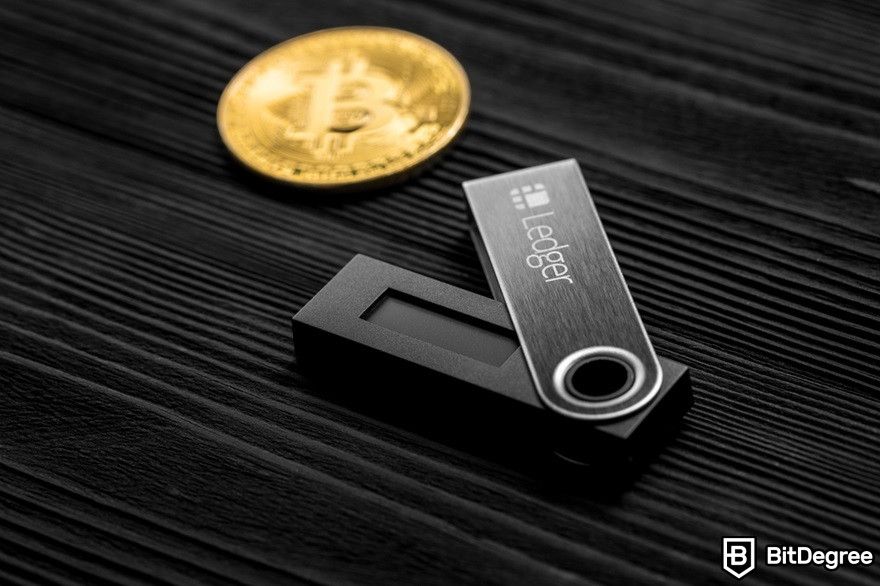
If you choose this route, ensure you have a secure crypto wallet to store your staked tokens and private keys.
My recommendation is Ledger Nano X. While it has a higher upfront cost compared to some software wallets, Ledger Nano X offers a robust and user-friendly hardware wallet solution. This investment provides peace of mind knowing your crypto holdings are protected with the most advanced security measures available!
A Step-by-Step Guide
For illustration, I use Binance to stake Chainlink. It offers a user-friendly interface that simplifies the staking process, making it accessible to both beginners and experienced users.
Before you begin the Chainlink staking process on Binance, ensure you have a verified Binance account that involves completing KYC (Know Your Customer) verification and face verification. It means you need to provide identification documents, such as an ID card, driver’s license, or passport, and take a selfie for liveness verification. This helps Binance comply with regulations and prevent fraud.
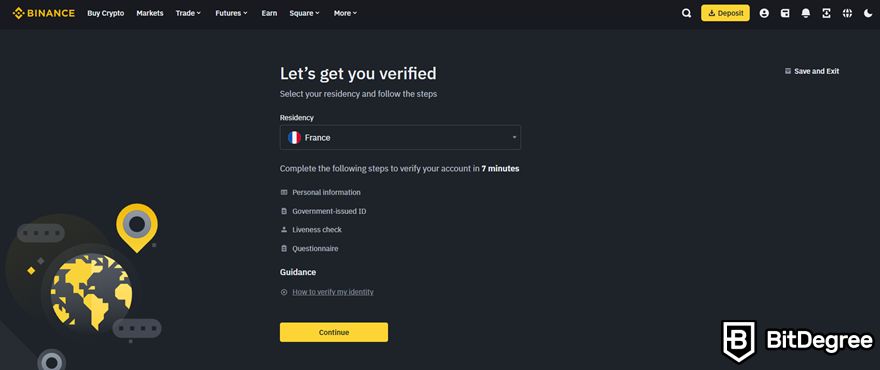
After finishing the verification process, wait for approximately 48 hours for Binance to review (Well, in my experience, it took only several minutes!).
Once your verification is approved, fund your wallet. You can use the "Buy Crypto" feature on Binance to quickly purchase LINK using fiat. To do that, follow these steps:
Step 1: Navigate to the "Buy Crypto" section on Binance. Then, choose your preferred fiat currency (USD, EUR, etc.) and select LINK as the cryptocurrency you want to buy.
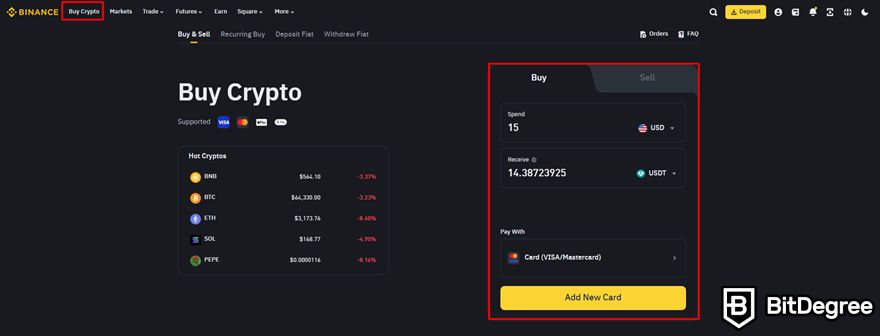
Step 2: Pick a supported payment method (debit/credit card or bank transfer) and follow the on-screen instructions to complete your LINK purchase.
After you have LINK tokens, navigate to the "Earn" section on the top menu bar to start staking LINK. If you access the platform via the mobile app, go to your profile and click “Simple Earn”. Click on the token and hit the "Subscribe" button.
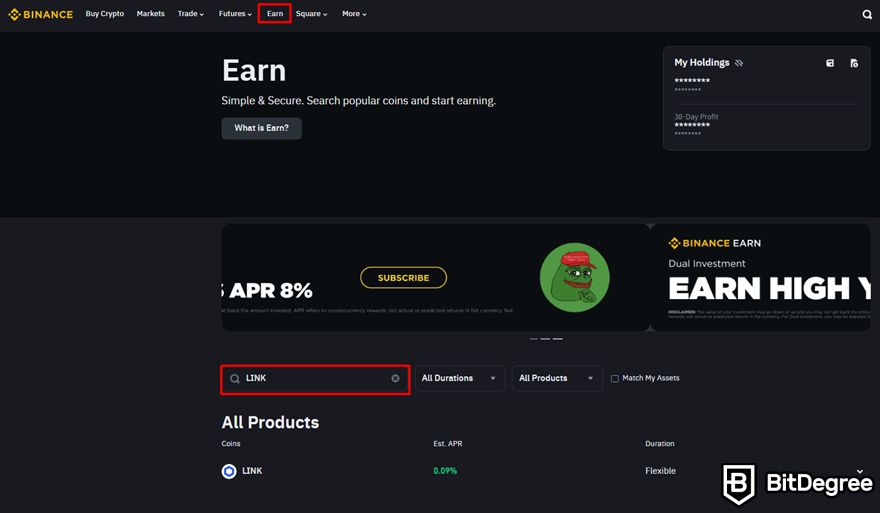
Then, search LINK, click on it, and select the amount of LINK you wish to stake. The good news is that Binance offers a flexible lock-up period for LINK staking, meaning you have more control over your LINK tokens.
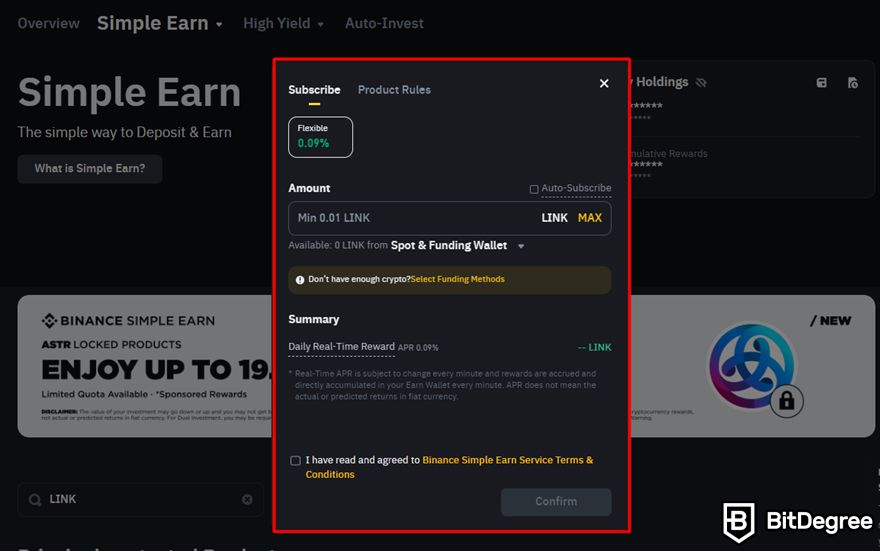
If your circumstances change (e.g., needs for cash or market volatility), a flexible lock-up allows you to withdraw your LINK tokens anytime. While you might forfeit some potential Chainlink staking rewards for early withdrawal, it provides added flexibility.
Also, note that flexible staking products typically offer lower APYs compared to fixed lock-up options. This is because you're not committing your tokens for a set period.
Once you’re sure of the amount of LINK you stake, the final step of Chainlink staking on Binance is to review the details of your selection and confirm the transaction to initiate the process.

- Secure and reliable
- Accepts fiat currencies
- Lots of trading options
- Reputable exchange
- Accepts fiat currencies
- Offers various trading options

- Huge trading variety
- Regulation-compliant around the globe
- Fair trading fees
- Beginner-friendly
- A wide array of features
- Vast number of different crypto coins & tokens

- Beginner-friendly
- Secure
- Decent trading and withdrawal fees
- Crypto.com Visa Card
- Automated tools & bots
- Ecosystem synergy with CRO
Best Practices for Beginner Stakers
Staking cryptocurrencies (Chainlink in this case) offers a way to earn passive income on your holdings. However, as a beginner, navigating this new territory can be daunting.
My first suggestion is to research the specific staking mechanism of the coin you're interested in and choose your platform wisely. Consider factors like Annual Percentage Yield, minimum staking requirements, and platform fees when comparing different staking platforms.
I've listed the recommended platforms above as your guidelines to get started with your research.
Once you decide on a specific token and platform, understand any potential risks, including lock-up periods, slashing penalties (for specific protocols), and platform security risks.
When you’re ready to stake Chainlink (or generally any token you choose), begin with a smaller amount of tokens you're comfortable staking. This allows you to gain experience and understand the process before committing larger sums.

After you've familiarized yourself with the staking process, keep track of your staked tokens, rewards earned, and the performance of the LINK token. This allows you to make informed decisions about your staking strategy. Consider joining the Chainlink community on Telegram to connect with other stakers, ask questions, and stay updated on the latest project developments.
Furthermore, always be aware of scams. Malicious actors may create fake staking platforms that promise unrealistic returns. Only interact with reputable staking platforms and conduct thorough research before committing your LINK tokens.
Well, I’m not trying to scare you, but the scams don’t end there! Scammers might also attempt to phish for your private keys or wallet recovery phrase, offer fake investment advice related to Chainlink staking, or try to impersonate legitimate support channels.
Just be extra careful of unsolicited investment offers, unrealistic returns, and any pressure to act quickly. Only trust official Chainlink resources and reputable staking platforms.
Conclusions
Chainlink staking offers possibilities for both seasoned veterans and crypto newcomers to contribute to the security of the Chainlink network while potentially earning rewards for your efforts.
It lets you tailor your staking experience to your risk tolerance and comfort level. For those seeking user-friendly interfaces and lower minimums, CEX staking with platforms like Binance or KuCoin provides a convenient entry point. Alternatively, if control and potentially higher rewards are your priorities, direct network staking can be a better option.
Remember, with great opportunity comes responsibility. Before diving in, it's crucial to do thorough research and fully grasp the trade-offs between security, control, and potential rewards. This ensures you make an informed decision that aligns with your financial goals.
The content published on this website is not aimed to give any kind of financial, investment, trading, or any other form of advice. BitDegree.org does not endorse or suggest you to buy, sell or hold any kind of cryptocurrency. Before making financial investment decisions, do consult your financial advisor.
Scientific References
1. E. Toufaily: ‘An Integrative Model of Trust Toward Crypto-Tokens Applications: A Customer Perspective Approach’;
2. A. Hassan, I. Makhdoom, W. Iqbal, A. Ahmad: ‘From Trust to Truth: Advancements in Mitigating the Blockchain Oracle Problem’.

